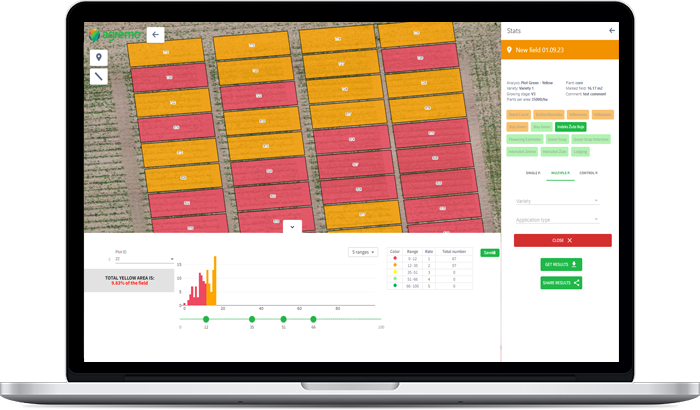“Yellow” is an innovative analysis that accurately identifies and addresses stress, diseases, drought, maturity levels, and plot uniformity in vegetation by detecting and quantifying yellow areas, enabling comprehensive crop management and decision-making.

The optimal time to apply Yellow analysis is in early and mid season for all focus crops such as wheat, barley, corn, canola, sunflower, sugar beet, soybean, potato.
| Crop name | Vegetation phase |
|---|---|
| Wheat/Barley | Mid-season, harvesting |
| Corn | Mid-season, harvesting |
| Canola | Mid-season, harvesting |
| Sunflower | Mid-season, harvesting |
| Sugar Beet | Mid-season, harvesting |
| Soy | Mid-season, harvesting |
| Potato | Mid-season, harvesting |

No credit card required
Plant stress analysis provides plot-level insight by identifying the percentage and specific locations of stressed areas in vegetation and soil. This comprehensive assessment includes various stress factors that affect the entire plot. In contrast, the yellow color index focuses exclusively on non-green vegetation, producing results at the vegetation level.
It is recommended to use in early season – mid season. The yellow color index offers a comprehensive assessment of vegetation health at the plot level. It identifies stress in vegetation, including factors such as disease, pest damage, weeds and drought. In addition, it can help detect the maturity of the plot by monitoring the vegetation. For example, if 50% of the soybean plot is yellow, this indicates maturity.

Agremo's AI solution turns DJI's drone imagery into actionable insights, and its recipe maps make our AGRAS drone a truly intelligent and precise spraying tool." The integration of the Agremo platform between Agremo and the DJI drone is a turnkey solution for precision agriculture.

The biggest benefit for farmers who use drones and Agremo reports is that they increase their yields, reduce costs or improve their productivity. In the end, all these benefits are lead to extra profits.

Agremo Stand Count analysis shows how successful seeding was and how many plants farmers will be able to harvest. Withal, it can help to apply different sowing standards in different parts of the plot, in order to achieve the highest yields.